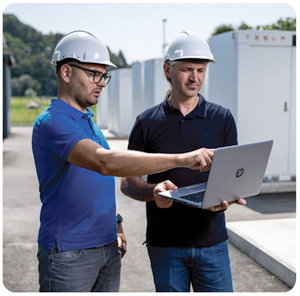 The shared desire for a carbon-free future is also changing the energy landscape. Renewable energy sources are increasingly replacing fossil-fuel generated power. However, electricity production from renewable energy sources is not as stable.
The shared desire for a carbon-free future is also changing the energy landscape. Renewable energy sources are increasingly replacing fossil-fuel generated power. However, electricity production from renewable energy sources is not as stable.
The electricity transmission system operators, ELES in Slovenia and HOPS in Croatia, have been facing the challenges of overvoltage and lack of flexibility resources for voltage regulation in some parts of the network. In addition, they identified new challenges due to the growing share of energy produced from dispersed, renewable energy sources and the increasing need for flexibility.
Therefore, in 2014, they decided to find solutions together. They teamed up with the electricity distribution system operators in Slovenia (SODO) and Croatia (HEP ODS) and initiated the first European project to introduce digitalisation in energy infrastructure.
Slovenia and Croatia decided to present the project to the European Commission (EC) as a proposal for a Project of Common Interest (PCI) in the field of smart grids. As a result, in 2015, the EC included the project on the PCI list. The contract on cofi nancing of the project by the EC was signed in 2017.
Innovative integration of mature technologies
The partners integrated already established technologies – compensation devices, battery energy storage systems and the dynamic thermal rating system – into the Slovenian and Croatian electricity network in an innovative way. In addition, a virtual cross-border control centre was set up to control and regulate the voltage in both systems. Such integration has increased synergies and the economic efficiency of the investment.
ELES and HOPS installed six compensation devices – three variable shunt reactors, two static VAR compensators, and a mechanically-switched capacitor with a damping network. With the installation of those devices, they achieved the goals of voltage profile control and the possibility of voltage regulation in the electricity systems of both Slovenia and Croatia. Furthermore, this innovation by ELES and HOPS also introduces the completely-new possibility of joint regulation of both systems. As a result, compensation devices will contribute to better network stability in emergencies. Moreover, the effects of their operation will also positively impact the networks of neighbouring countries.
Two battery energy storage systems with a total capacity of 10 MW (50 MWh) that were installed in Slovenia will increase the flexibility of active power and thus the reliability of the system operation. They will also facilitate the transition to future electricity systems where the production of electricity from dispersed renewables and the active participation of prosumers in the energy market will prevail.
In the scope of the project, the dynamic line rating (DLR) algorithms and models for the DLR system, that calculates the dynamic thermal limits of transmission lines for operation in real-time and short-term forecast, were improved.
ELES and HOPS utilise the results to improve the safety of operation and the transmission capacity of the network. This way, the existing infrastructure is used in the most efficient way. Furthermore, with the increase of cross-border transmission capacities, it is also possible to transfer larger quantities of energy from renewable sources in the south of Croatia to the markets in the region.
A common application was installed in both national control centres, forming a unique, virtual cross-border control centre. This is the first case in Europe where neighbouring transmission system operators have joined forces in regulating and optimising the voltage in their networks.
Additionally, advanced solutions were implemented at ELES' control centre, such as an IT platform for the integration of prosumers in ancillary services, a communication platform for operational data exchange between transmission and distribution system operators, an upgrade of the metering system to support modern data exchange based on the latest standards, an upgrade of the solar production forecasting tool and modernisation of the ICT infrastructure.
The SINCRO.GRID project demonstrated how distribution and transmission system operators can enable their existing infrastructure to accept larger quantities of electricity from renewable sources while ensuring a reliable electricity supply.

Joint integration of devices has increased the economic efficiency of the investment and has also had a positive impact on the networks of neighbouring countries.
Contact details:
Web: www.sincrogrid.eu
LinkedIn: @SINCRO.GRID Project